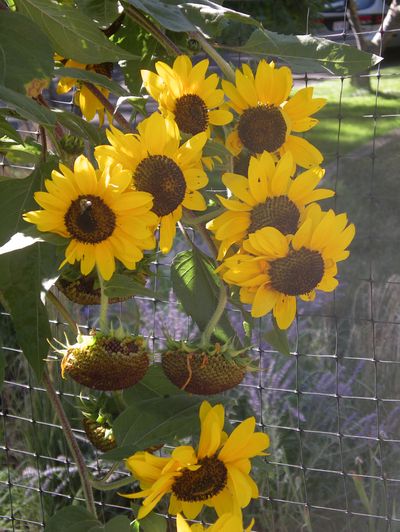Sunflowers perfect for displays, great treat for birds, bees

Late summer into early fall is sunflower season. Outside my office window the birds spend this time of year feasting on sunflower seeds, not only from the feeders but also from the sunflowers that have grown from spilled seed.
Although I haven’t planted sunflowers in years in the vegetable garden, there is a forest of stalks topped with bright yellow disks in various stages of blooming and ripening. The honeybees are all over the just-opened ones looking for nectar and pollen to top off their stores before winter. The flowers that have finished blooming and are now full of seed are being stripped by the birds as fast as they can.
Most of us are familiar with the giant stalks with 2-foot-wide flowers, but sunflowers can be as short as 15 inches and everything in between. The grand champion at the Spokane County Interstate Fair this year was about 15 feet tall, and the world champion grown in the East came in at over 25 feet. Besides the familiar yellow, the flowers come in shades of rust, gold, mahogany, white and combinations of all of these.
Sunflowers need lots of sun and reasonably good soil. They are somewhat drought-tolerant but benefit from a steady supply of water to reach full height. Some large stalks may need to be staked against the wind. Seeds are planted in the spring when the soil warms, while sprouts can be moved when they are young.
Sunflower bouquets are the hallmark of late summer, and the farmers markets have them in abundance now. Cutting your own flowers does take a little care and planning. Cut the flowers from well- watered plants as early in the day as possible and place them immediately in a bucket of water in the garden. Prepare your tall vases with fresh, cool water before arranging the flowers. Remove the flowers from the garden pail, trim the ends again and place them in the vase immediately. A good bouquet can last over a week.
Be a Master Gardener
The Washington State University/Spokane County Master Gardener Volunteer Program is looking for a limited number of community-minded gardeners to join their ranks and has opened the application process for the new trainee class scheduled to begin in January.
WSU Master Gardener volunteers serve as a link between WSU research-based horticulture information and the general public.
To be considered for the program, you must complete an application, be accepted for the program and complete an online training course as well as attend several scheduled classes. Upon graduation, each person must volunteer at least 40 hours a year.
WSU Master Gardeners function as community educators, and the volunteer requirement of the program is what distinguishes Master Gardener volunteers from members of garden clubs and other organizations. Ongoing availability for daytime volunteer work and continuing education classes are necessary. Cost of the program is $200. Some partial scholarships are available.
Master Gardener applications will be accepted until Oct. 30. The application packet is available at www.spokane- county.wsu.edu/spokane/ eastside/ or call (509) 477-2048 to receive information by mail.